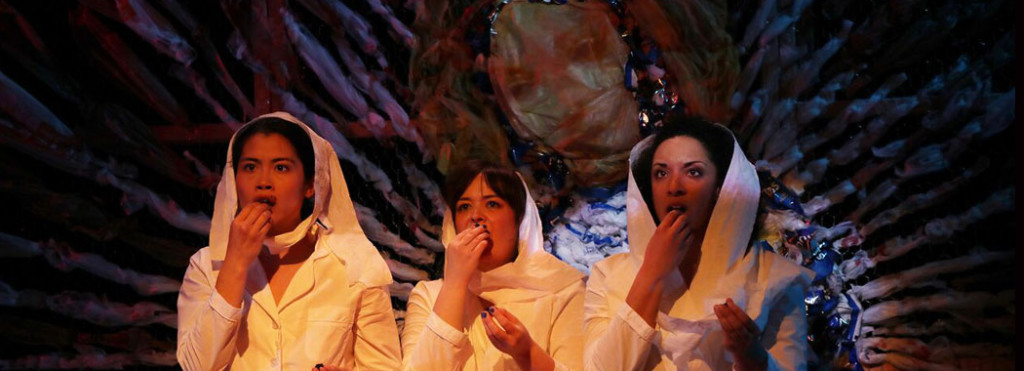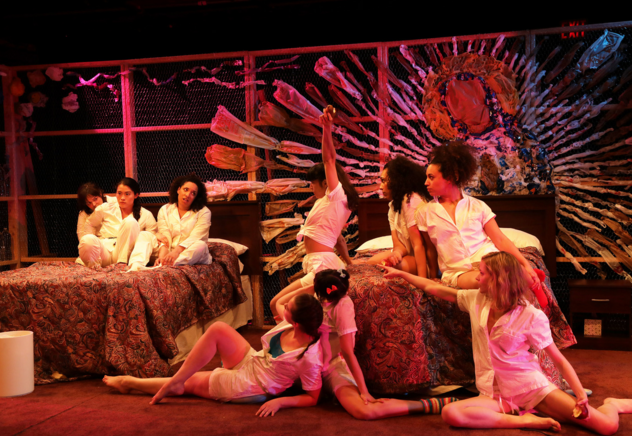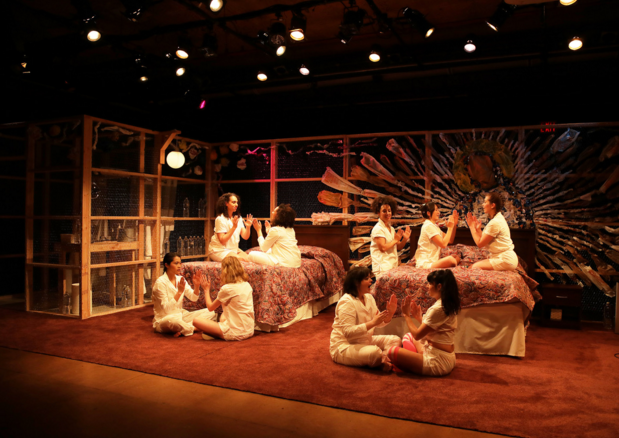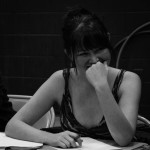
Martyrs, a new play at La Mama Experimental Theatre Club written by Romana Soutus, raises a question regarding plurals. The press release and website advertise the play as “a convent slumber party turned upside down as tensions rise and relationships erupt. Cats and Kittens let you in on midnight whispers between sisters.”
The play itself has three actresses (Lindsay Rico, Kayla Jackmon, Madison Fae) as the Cats, the leaders of the group of women gathered in a space that looks like a comfortable room in the midst of an underground bunker surrounded by barbed wire. Six actresses play their respective Kittens, younger women who look to their Cats for wisdom, affection, and nourishment of the mind and soul.
In the program, the characters are listed as “Cat 1, Cat 2, and Cat 3,” and the same format is used for the six Kittens. Yet the play leaves a question in the audience’s mind that is never answered – are there nine women in this bunker, or two? Are the Cats three separate women or three sides of the same person?

When a Kitten slaps one Cat in the face in an act of anger and defiance, all three Cats react to the pain. If a Cat asks a Kitten a question, more than one might answer. But every Cat and Kitten uses the word “I,” not “we,” when referring to herself, and when Cat 2 tells the story of Creation, one Kitten eagerly adopts the role of the Serpent, three other Kittens listen with varying levels of interest, and two turn their heads and fall asleep during the performance.
The three Cats also have clearly defined personalities. Rico’s Cat 1 is a fierce general, the clear leader of the three, managing to be both cold and passionate at the same time. Jackmon’s Cat 2 is the most maternal and warm, inviting her brood of Kittens to share her experience. Fae’s Cat 3 seems least prepared for the responsibilities of leading a group of younger women, easily flustered and frustrated, as though she were a big sister thrust into the role of a mom. Yet all three Cats react in sync when the Kittens disobey them, and they all have the same desire: to be “lifted,” and achieve enlightenment.
In another play, this ambiguity could lead to frustration and confusion on the part of an audience member. The question of the characters’ identities lingers throughout Martyrs, and while it is occasionally distracting, the ambiguity is largely a feature of the production rather than a bug. Whether each Cat or Kitten represents multiple women or one woman each, the play still works as a rich, emotional portrayal of the relationships women have with one another, with themselves, and with their bodies.
The strength of the play lies in the collaborative nature of the production. Martyrs was written by Romana Soutus and developed with and directed by Pirronne Yousefzadeh, and imagining the conversations between playwright and director to develop the story is worthy of its own play. The actresses have a natural, effortless chemistry, encompassing all of the intense emotions inherent in relationships between women.

The most surprising part of Martyrs is the twist on the mentor/student dynamic. The Kittens alternate between disobeying the Cats and begging for their approval, but they also worry about the Cats more than their older counterparts worry about them. The daughters are encouraging their mothers to eat when the mothers refuse food; the little sisters reassure their big sisters that they are “good enough” and worthy of love. Living in a world where women are socialized to be hard on themselves, I wondered if Martyrs was a hopeful statement about the power of the younger generation – how today’s teenage girls and young women will grow up to be more accepting of their bodies and less hard on themselves for failing to achieve perfection.
There were moments during Marytrs where I wished the script was less vague in its purpose and in its dialogue. I wanted the play to be more direct about why these women were having this slumber party and what they hoped to achieve from it. I wanted to know more about their relationships before they entered this bunker. I wanted less time with karaoke machines and looking for double meanings behind Natalie Imbruglia’s “Torn,” and more time focusing on the uncomfortable parallels between the language of a devout, fasting nun and a teenage girl with an eating disorder.
Mostly, however, I wish I had taken a friend to see the show so we could have spent the train ride home talking about it. There would have been a lot to say.








